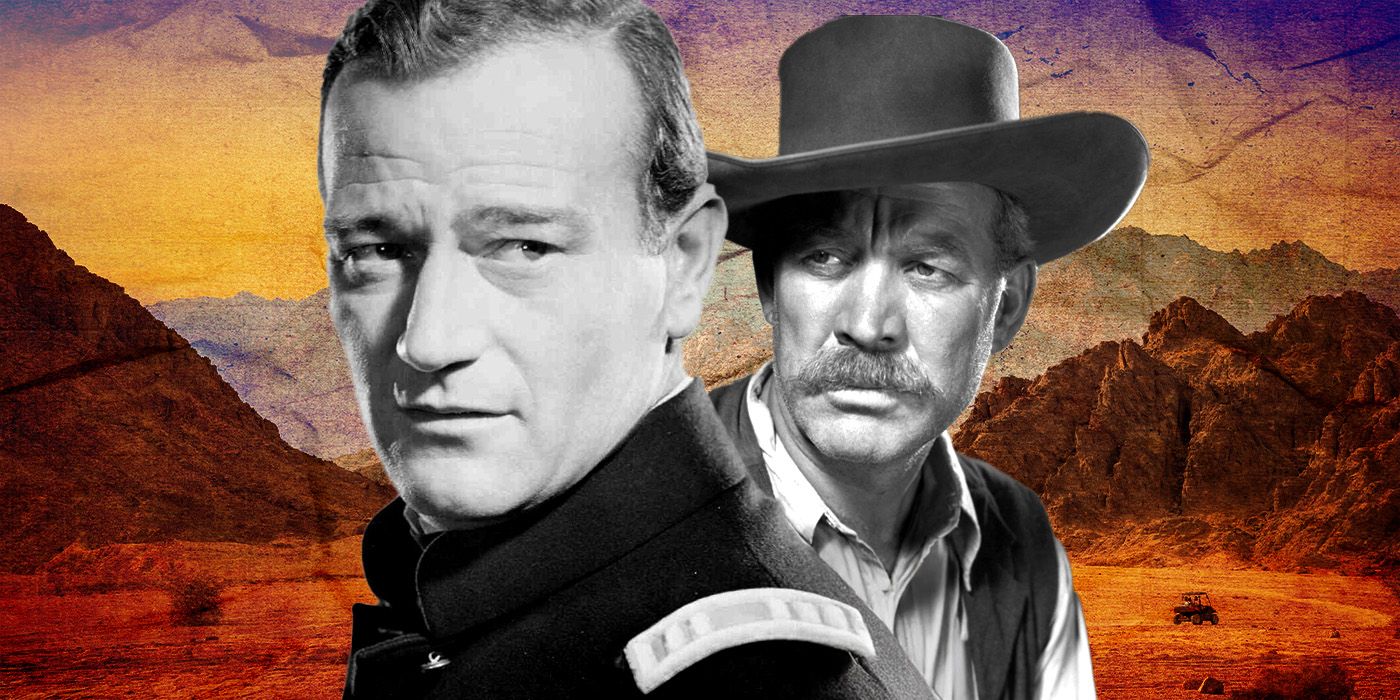John Wayne was positioned as a cultural superhero long before superheroes were a tangible genre in Hollywood. He wasn’t just a cowboy actor, but a crusader for the mythological image of America as the land of truth, justice, and self-preservation. Therefore, many villains in his films tend to come off as unmemorable and limp, since their only purpose is to be obstacles for Wayne to righteously shoot down. Mainly due to how supernova Wayne was as a star, most actors weren’t comparatively big enough to plausibly challenge him on-screen, and that’s why Lee Marvin is a unique presence in Wayne’s filmography. His raucous turn as the titular baddie in The Man Who Shot Liberty Valance is the only time Wayne ever squared off with someone who stood toe-to-toe with him and didn’t get instantly blown off the screen.
Liberty Valance Is a Classic Bully
When law student Ransom Stoddard (James Stewart) rides into the town of Shinbone, his carriage is held up by the outlaw Liberty Valance (Marvin) and his gang. Valance not only robs him of his money, but humiliates and whips him for his interest in the law and reading, with such viciousness that even his boys have to hold him back. Upon arriving in town, he learns that Valance regularly terrorizes the town with little repercussion, as not even the local law enforcement is brave enough to stop them. The only person with the courage to do it is Tom Doniphan (Wayne), but Doniphan refuses to take Valance out until Valance takes him up on his offer of a one-on-one duel. Ransom refuses to be as meek as the townsfolk, believing that proper legal matters can bring Valance down, but Tom insists that he needs to learn to pick up a gun and defend himself. Valance becomes such a persistent problem that Ransom may have to see things Tom’s way, leading to one of the great showdowns in Western history, and it wouldn’t be half as hair-raising if not for Lee Marvin’s performance.

Related
The West never looked the same following this 1948 gem.
Lee Marvin Could Stand Toe-to-Toe With John Wayne
Liberty Valance’s reign of terror is an ironic one, as it was a relatively short-sighted venture, unconcerned with expansion or ideological pursuit. He’s just a bully who thrives on the power he holds over the defenseless citizens, content to rule his little anthill as long as no one truly pushes back. Like all bullies, he’s a coward who needs to either outnumber people with his backup crew or go up against someone he thinks he can trample. Usually, a character this simplistic is the stuff of cannon fodder, but Lee Marvin makes him so magnetic in his cruelty and so uproarious in his own amusement that he does the impossible and steals scenes from Wayne and Stewart. Marvin hadn’t yet hit the heights of his stardom, like with his Oscar win for Cat Ballou or his own signature films like Point Blank, but he’d already built a reputation as a tough guy unafraid to scar the audience with his actions. If the audience bought any actor believably unintimidated by John Wayne’s all-encompassing starpower, it’s the guy who gained onscreen notoriety for throwing scalding hot coffee into Gloria Grahame‘s face in The Big Heat. Liberty Valance may not have any complexity, but he’s a persuasive kind of evil that’s key to the film’s overarching message, which wouldn’t have landed without Marvin’s bracing work.
Liberty Valance Stands Against John Wayne’s Principles
The Man Who Shot Liberty Valance might be the film that created the infamous quote “when the legend becomes fact, print the legend,” but it’s equally suspicious of the power of the legend. Similar to other John Ford films like The Searchers, the film interrogates the “pull-yourself-up-by-your-bootstraps” philosophy that many other Westerns swore to while still acknowledging why it stuck around for so long. Ransom effectively gets bullied into doing what Tom says and falls in line with his pro-gun position because he’s told there’s no other way, and the film doesn’t trust how that decision seemingly benefited Ransom’s life. In this conundrum, Liberty Valance serves as the “evil” side of the coin that Tom Doniphan is the “good” side of: the need to stand your ground and finish fights you didn’t start as a tool for self-preservation and maintaining your identity in American culture. For this notion to work, Valance needs to be evil in a way that counteracts the noble poise of Doniphan, his blustering spitefulness in contrast to Doniphan’s refined dignity. Valance stands above other John Wayne villains, not because of his actions or impact on the plot, but because of how Lee Marvin plays him as the antithesis of everything John Wayne and John Ford stood for as crafters of the American mythos they spent a shared career believing in.

The Man Who Shot Liberty Valance
- Release Date
-
April 22, 1962
- Runtime
-
123 Minutes
- Director
-
John Ford
- Writers
-
James Warner Bellah, Willis Goldbeck, Dorothy M. Johnson
Source link


